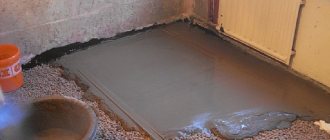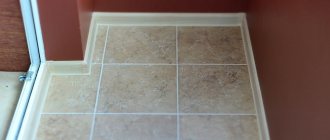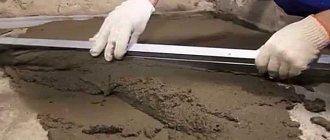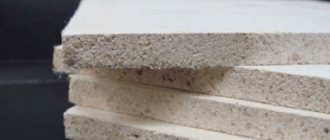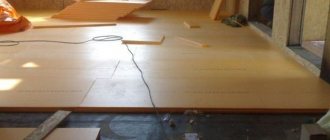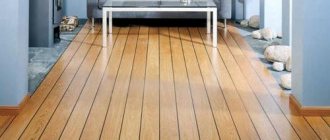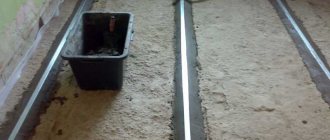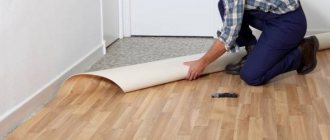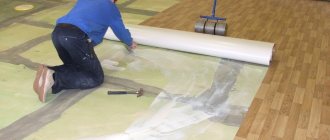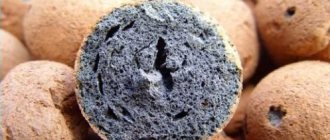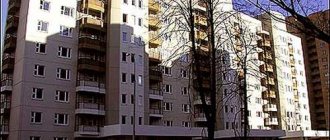High-quality finishing work largely depends on the correctly selected material. Thanks to modern technologies, the construction market is saturated with various options. But for rough or finishing floor coverings, the most popular are OSB, plywood, chipboard, fiberboard and MDF. This variety allows you to select a product to perform specific tasks.
What is the difference and what is common between OSB and chipboard
First, some definitions.
Chipboard is a chipboard made by pressing from wood chips of arbitrary shape.
OSB is a wood board, for the production of which specially shaped shavings are used, which are oriented in certain directions before forming the boards. The plate consists of three layers. In the outer layers, the chips are oriented in one direction in the plane of the slab, and in the middle layer - perpendicular to the outer layers in the same plane.
The name OSB is obtained by transliteration of the English name - Oriented Strand wood construction Boards (OSB). Along with them, the Russian-language term and the corresponding abbreviation are used - Oriented Strand Board (OSP).
Both materials compared are composites based on wood waste. They are manufactured in the form of sheets or slabs of different thicknesses and sizes. In both cases, the boards are formed from wood chips using formaldehyde resins. This is where the main similarities between them end.
The main difference between OSB and chipboard can be seen from the above definition. This is a special shape and orientation of the chips.
Chipboard is produced with a thickness of 1 mm and above, in increments of 1 mm. The most commonly used plates are 10, 16 and 18 mm thick. These are furniture standards. The most popular sheet formats are 2750x1830, 1830x2440, 2800x2070 mm. But there are a lot of options, starting from 1800 in length and 1200 in width.
OSB has a thickness from 6 to 40 mm in 1 mm increments. The most commonly used formats are 2500x1250 and 2400x1220 mm, although there can be a variety of options. The minimum size defined by the standard is 1200 mm. In addition to ordinary rectangular sheets with a smooth edge, tongue-and-groove slabs are produced, which are convenient to use as cladding. When they are joined, the profiled edges form a lock that aligns adjacent panels into one plane.
According to their physical and technical parameters, each material is divided into grades or types.
Chipboard:
- type P1 – for general use;
- type P2 – for dry indoor conditions, including for furniture manufacturing.
OSB:
- OSB-1 – boards for unloaded elements used in dry conditions;
- OSB-2 – boards for load-bearing parts, for dry conditions;
- OSB-3 – boards for loaded products in wet conditions;
- OSB-4 – for wet conditions under increased loads.
What are the disadvantages of OSB building boards?
- The environmental friendliness of an OSB board depends on the connecting material used to glue its layers together. Some manufacturers add too much formaldehyde to the board, which makes it toxic and unacceptable for residential premises;
- Despite the declared moisture resistance, some wood chips, due to their large size, may react poorly to changes in temperature;
- And also some chips are poorly affected by moisture, which can lead to their deformation,
- The surface of OSB is not smooth, which is not suitable for all coatings.
Drywall (GKL)
It is rightfully considered one of the most popular materials for leveling walls, ceilings and floors, installing interior partitions and even decorative elements such as arches, columns, spheroids, multi-level ceiling coverings, etc. The main component of plasterboard sheets is gypsum filler and this determines many of the positive qualities of the building material.
Thus, drywall is chemically inert, its acidity is approximately equal to the acidity of human skin, it does not contain and does not release chemical compounds harmful to humans into the external environment. A standard board consists of 93% gypsum dihydrate, 6% cardboard and another 1% surfactants, starch and moisture.
Thus, the fragility of the panels complicates their transportation and loading and unloading operations. For the same reason, gypsum board cannot withstand significant physical stress and is not recommended for leveling floors. Suspended plasterboard ceilings can withstand a weight of no more than 4 kg per square meter, while suspended ceilings can bear a load of more than 100 kg per square meter.
Drywall
A variation or more modern modification of a simple sheet of plasterboard is painted or laminated plasterboard, gypsum vinyl or gypsolam - colored plasterboard with a vinyl coating. A fundamentally new material that has an initially exclusive appearance with a wide selection of decor. It is used for interior wall cladding, for covering window slopes, creating partitions, showcases and exhibition shelving, without additional finishing.
Laminated plasterboard, gypsum vinyl or gypsolam - colored plasterboard covered with vinyl coating
These environmentally friendly non-flammable panels are a gypsum board covered on both sides with special cardboard. They have ideal geometry and are used for constructing internal partitions and lining ceilings. Supplied in sheets 2700 (3000) x 1200 x 12 mm. Special grades of plasterboard are produced for wet (bathroom) and fire hazardous (wall near the fireplace) rooms.
They are painted in “signal” colors - red and green. There is also plasterboard of increased plasticity (thickness 6 mm, width 900 mm) for covering rounded walls. Sandwich panels are made from plasterboard with a heat-insulating layer of polyurethane foam (up to 50 mm). They are already used for internal cladding of external walls without subsequent insulation and vapor barrier. This significantly reduces construction time.
Advantages of drywall:
- environmental and sanitary safety;
- easy to process: cut, drill;
- does not burn, but is destroyed when heated significantly;
Disadvantages of drywall:
- low strength, fragility;
- greater vulnerability to moisture, even of a moisture-resistant variety;
- does not tolerate low temperatures and significant temperature changes;
- Suitable for interior decoration only.
Wood floor repair
Plywood or OSB sheets can be an ideal option for repairing an old wooden floor. For repair work, it is recommended to use whole sheets without cutting them into pieces. In addition, it is very important that the largest sheet is laid near the door, since this is where traffic is highest.
Various pieces and trimmings can be used along the walls or in places where furniture will be located. The ideal thickness for repair work should be about 12 mm. As when installing a new floor, it is necessary to leave a gap around the perimeter along the walls of about 2-3 cm. In this case, there should be no gap between the sheets. It is also recommended to glue the ends with a special assembly glue. This floor can last about 20 years.
What is stronger than chipboard or OSB?
The main strength parameters for wood composites are the flexural strength, elasticity coefficient (modulus) and fastener holding strength.
Since OSB consists of large chips that, due to their orientation, form a certain structure, higher strength values can be expected from these sheets. But let's turn to the technical conditions of GOSTs.
Chipboards have the following parameters:
- bending strength – minimum 11 MPa;
- elastic modulus – 1600 MPa;
- specific strength of screw retention is 35–55 N/mm.
Oriented Strand Board:
- bending strength along the structure of the outer layers: 18–20 MPa;
- strength in the transverse direction: 9-10 MPa;
- modulus of elasticity at longitudinal bending: 3500 MPa;
- modulus of elasticity at transverse bending: 1400 MPa;
- fastener holding strength: 80-90 N/mm, and for some manufacturers - up to 112 N/mm.
OSB board is 1.5-3 times superior to chipboard in terms of mechanical parameters, although it is somewhat inferior when loaded across the external structure.
Types of subfloors
Cement screed is considered the strongest foundation
Let's look at the most common bases for subfloors:
- cement strainer;
- dry floors; Usually the base of the floor is made of cement or concrete screed. This arrangement of a horizontal surface guarantees a reliable and strong subfloor base. Screeds are made in various ways.
Self-leveling mixtures or ordinary cement mortar are used, but in all cases the standard requirement for the height difference of the cement surface is 2 mm at a distance of 2 meters.
- Recently, more and more often, the construction of the lower surface of premises is made of dry floors. Expanded clay chips are mainly used for backfilling. Sometimes the backfill is covered with a thin layer of cement. The boards must be impregnated with protective compounds. Preparation of plank flooring for flooring is carried out in old houses. Before laying new coverings, the boardwalk is repaired. Where the boards sag or are partially destroyed, they are replaced with new floorboards. If the logs under the boards have become unusable, they are also replaced. The boards are impregnated with an antiseptic, and all surface imperfections are filled with putty.
In most cases, polymer insulation is placed on top of the filler or the backfill is covered with sheet wood boards.
Laying on joists
To cover the joists you will need thick sheets of plywood
If you want to cover the joists with plywood or OSB, you need to take care of installing additional supports in advance to avoid the floor sagging under load. To do this, transverse cuttings of bars are screwed between the joists onto the corners.
Otherwise, installation is almost no different from covering with floorboards; on the contrary, it is even simpler, since there is no need to join tongue-and-groove boards. The sheets are simply laid and screwed to the joists.
Screed alignment
When installing on a concrete base, it is recommended to first glue the sheets with an adhesive with good elasticity, and then screw them with dowels. Also sometimes a laminate underlay is placed under the sheets for sound insulation.
Installation of sheets on a substrate
This method is often used in cold utility rooms, since wood is much warmer than concrete and is more convenient to work on.
Adjustable floor
This installation method is the most labor-intensive, but allows you to get rid of large differences in the floor.
Instructions for installing sheets on adjustable legs with your own hands:
- To do this, holes are made in the sheets for pins and recesses for washers of larger diameter every 40-50 cm.
- A washer is placed in each recess and a hole is drilled in the base.
- The sheet is then temporarily removed and long anchor pins are installed in the holes. They are screwed into the floor to the same level.
- Nuts and washers are screwed onto the studs; they must be screwed exactly level. After this, the sheet is laid on the studs and screwed on top with a second washer. As a result, it turns out to be tightly fixed at the top and bottom, with the possibility of adjustment.
Thickness selection
When laying on a solid base (screed, wooden floor, etc.), the optimal thickness is 8-10 mm. If laying is done on logs or supports, then the thickness will depend on their pitch. With a pitch of 40-60 cm, the optimal sheet thickness is 15-18 mm; if the pitch of the supports is larger, sheets of 18-22 mm are used.
- When laying on a solid base (screed, wooden floor, etc.), the optimal thickness is 8-10 mm.
- If laying is done on logs or supports, then the thickness will depend on their pitch.
- With a pitch of 40-60 cm, the optimal sheet thickness is 15-18 mm; if the pitch of the supports is larger, sheets of 18-22 mm are used.
Note! To correct large unevenness in the floor, sheets are often laid in 2 thinner layers, with the joints offset. It makes sense to perform such an operation with OSB to increase the strength of the structure, but when laying plywood it will make less sense. This is due to its production technology: veneer sheets are initially laid in a perpendicular direction.
Appearance
For subfloors, this criterion is not so important, with the exception of grade IV plywood, which is not suitable for soft floor coverings. OSB is more suitable for finished floors; it has no surface defects and a more beautiful texture, especially after painting or varnishing.
Plasterboard
Plasterboards are a practical, modern and environmentally friendly material, as they are made without the use of toxic substances from natural gypsum, which does not conduct electricity and is odorless. The plasterboard meets all fire safety requirements. Gypsum board, gypsum tongue-and-groove plate (GGP) is the main material in the construction of partitions, suspended ceilings, and various decorative projections.
Used for leveling ceilings, walls, and “sealing” communication systems. Gypsum plaster can be moisture resistant and standard. Standard is used in buildings with normal humidity. Boards with hydrophobic additives are intended for damp rooms. Such slabs are easily distinguished by their characteristic green color.
Gypsoplate, gypsum tongue-and-groove plate (GGP)
Advantages of gypsum boards:
- environmental and sanitary safety;
- easy to process: cut, drill;
- low flammable material, flammability class G1
- relatively cheap.
Disadvantages of plasterboards:
- low strength, fragility;
- greater vulnerability to moisture, even of a moisture-resistant variety.
Which material is more resistant to moisture?
The wear resistance of the compared materials is entirely determined by the surface structure. Chipboard consists of small chips, which chip quite easily under abrasive loads. And since the outer layer has the greatest density, the wear rate increases over time.
On the surface of an oriented strand board, most of the area is occupied by large chips with an intact wood structure. When abraded, it is almost not damaged and can withstand heavy loads.
When choosing what is better to lay on the floor, chipboard or OSB, the answer will be in favor of OSB. However, it is worth remembering that none of these materials are intended for use as the front, finishing layer of finishing, therefore their wear resistance is not standardized, but only determined from practice.
In humid conditions, chipboard very quickly loses strength, and with strong moisture it completely collapses.
When testing for moisture resistance, OSB-3 is placed in water at room temperature, the bath is heated to 1000C for 90 minutes, kept for 2 hours, and then cooled to 200C in an hour. After drying, the sample shows a flexural strength along the main axis of 7 - 8 MPa. That is, its strength decreased by approximately 2.5 times, but the sample retained its integrity and part of its structural strength.
Comparison of main characteristics
Despite the similarities in production technology and application, the materials under consideration have many differences.
- Strength. Chipboard is not able to withstand heavy loads, while OSB-3 and OSB-4 are used for the manufacture of load-bearing structures.
- Moisture resistance. And again, chipboard is inferior - it tends to deform even with slight exposure to water or steam. OSB can remain in a room with high humidity for some time without consequences.
- Reliability. Both materials do not tend to delaminate, but the chipboard sheet is more fragile, so its ends are more likely to crumble.
- Price. Chipboard is much cheaper than its competitor, but given the number of shortcomings and strength characteristics, this is quite justified.
- Treatment. Both building materials are easy to cut, grind and drill. Although chipboard has a significant drawback - it crumbles. Therefore, re-tightening a screw into the same hole is impossible without first treating it with epoxy resin.
Gypsum fiber sheet
Gypsum fiber sheet (GVL) is a modern environmentally friendly homogeneous material with excellent technical characteristics. It is produced by semi-dry pressing of a mixture of gypsum and cellulose waste paper. In terms of its physical properties, gypsum fiber sheet is a fairly strong, hard material, also famous for its fire-resistant qualities.
Gypsum fiber sheet, due to its versatility, has become very widespread in the construction industry. It is used for the installation of interior partitions, floor screeds, suspended ceilings, wall cladding and fire protection of structures. GVL for the floor, which is used to assemble the base of the floor covering, is popular, as well as the facing option, with which, for example, wooden surfaces are sheathed, thereby increasing their fire resistance. Depending on the area of application, gypsum fiber sheets are divided into two types: GVLV (moisture resistant) and GVL (regular).
Gypsum fiber sheet. Floor installation
Advantages of gypsum fiber sheets:
- GVL, compared to gypsum plasterboard, can more easily withstand sawing in any direction, since it is homogeneous in composition;
- Higher strength due to cellulose fiber reinforcement;
- Increased sound insulation.
Disadvantages of gypsum fiber sheets:
- Less bending strength than gypsum board;
- Less suitable for interior decoration than gypsum board;
- The need for pre-treatment before painting.
Glass-magnesium sheet or glass-magnesite sheet (SML) is white, reinforced with fiberglass, 40 percent lighter than GVL, flexible, durable, fire-resistant, moisture-resistant. Thanks to the reinforcing fiberglass mesh, the SML can bend with a radius of curvature of up to three meters. This quality allows it to be used on uneven surfaces.
High moisture-resistant qualities allow it to be used in rooms with high humidity. Any finishing materials can be glued to the front side of the slab. With a sheet thickness of 6mm, it is capable of holding fire for 2 hours and can withstand heating up to 1500 degrees. Sheet thickness: 3-20 mm.
Glass-magnesium sheet (FMS) is a universal sheet finishing material based on magnesite and fiberglass. The manufacturing technology and composition of the material give it such qualities as flexibility, strength, fire resistance and moisture resistance. Its qualities allow it to be used on uneven surfaces and reduces the possibility of sheet fracture during installation and transfer.
The scope of application of glass-magnesium sheet is extremely high. Like plasterboard, it can be used to make ceilings, walls and interior partitions. Moreover, glass-magnesite sheets can be used to decorate the external facades of cottages and houses. SML is a reliable basis for any type of finishing. The new material is ideal for showers, saunas, and swimming pools - after all, the glass-magnesium sheet can withstand high humidity, temperature changes and open fire.
The front (smooth) surface of the sheets is intended for painting, wallpapering, laminating and applying various types of decorative textures without preliminary, final puttying and priming of the entire surface of the material. The back (rough) surface of the sheets is designed for strong adhesion when gluing piece facing and decorative materials (ceramic or tiles, veneer, etc.
Along with conventional glass-magnesium sheets, laminated glass-magnesium sheets with a variety of patterns and thickness of the outer coating have recently begun to appear more and more often.
SML Glass magnesium sheet, glass magnesite sheet or glass magnesite
Advantages of glass magnesite:
- Moisture resistance - does not undergo deformation, does not swell and does not lose its properties;
- Fire resistance - magnesite panels are non-flammable material;
- Good sound insulation - a 12mm panel in terms of sound permeability corresponds to four layers of twelve millimeter plasterboard sheet, or a 150mm thick brick wall;
- High strength and flexibility - can bend with a radius of curvature from 25 cm to 3 meters;
- Lighter than similar slabs made of wood or gypsum;
- Low thermal conductivity, can be used as additional insulation;
- Can be used for finishing both outside and inside.
Disadvantages of glass magnesite:
- More fragile than gypsum fiber sheet;
- When filling joints, it is necessary to use putties with chemical adhesives;
- Properties vary significantly depending on the manufacturer and class of LSU.
OSB or plywood - choosing the best option
Each material has positive and negative properties. It is advisable to compare them with each other, taking into account operating conditions, load level, and intensity of exposure to moisture. Advantages of plywood:
- creates an even coating, which is important when installing under laminate or parquet;
- returns to shape after short-term wetness;
- provides thermal insulation;
- resists the effects of loads, while the material does not deform, which is due to its structure;
- there is a choice of environmentally friendly materials for rooms with high and low humidity levels (different types);
- ease of preparation for installation.
INTERESTING: Semi-dry screed: do-it-yourself manufacturing and installation technology
Disadvantages of plywood:
- with frequent contact with moisture, the material becomes deformed;
- Curvature of sheets appears under the influence of significant and sudden temperature changes.
Positive qualities of OSB boards:
- strength;
- versatility;
- the content of harmful substances is minimal, the material is not hazardous to health, and therefore it is permissible to use it for installation inside residential premises;
- attractiveness of sheets;
- wear resistance, so OSB lasts a long time.
But there are a number of disadvantages that limit the use of such material:
- low vapor permeability;
- there is a risk of release of toxic components (formaldehyde) if the board production technology is violated (for example, some companies deliberately take such measures in order to reduce the cost of the material).
Cement particle boards
Cement particle boards (CPB) are an ideal material for the outer cladding of frames and partitions in wet and flammable rooms, and serve as a good leveling base for any floor coverings. It has a hard and smooth surface, can be plastered and tiled, sawn with a hacksaw, is non-flammable, resistant to moisture and temperature fluctuations. Supplied in sheets 3600 x 1200 x 10 (12, 16, 20 and 26) mm.
DSP slabs are laid in one layer, the thickness of the slabs is from 10 mm, the disadvantages of this material include:
- difficulty in installation
- heavy weight
- relatively high cost
To the advantages:
- Increased mechanical strength;
- Moisture resistance
Installation is carried out in many ways similar to the installation of plywood, with the only exception that to cut the sheets you will need a “grinder” and the sheets themselves are larger in size and weight.
Separately, you can specify one of the varieties of DSP - “Aquapanel” from Knauf. These boards are distinguished by complete moisture resistance, resistance to fungus and mold, great resistance to mechanical damage and crumbling, the ability to bend onto curved surfaces - the material is reinforced with fiberglass mesh, so it does not break.
In new buildings, dry screed technology is used: gypsum fiber sheets (gypsum fiber sheet) laid overlapping with an offset of 2-3 layers over fine expanded clay. At its core, it is a ready-made base on which the finishing is laid without any additional preparation. It is widely used for leveling concrete floors, instead of a traditional screed, and is also suitable for leveling subfloors over wooden joists, but in our opinion, when leveling or installing a wooden floor in a new house, it is more reasonable to use plywood or fiberboard. Among the advantages of “dry screed” from GVL:
- Speed of installation
- Light weight
- The floors are warmer than when using DSP
- More bending resistant than plywood
- Not afraid of water
Disadvantages of “dry screed” made of gypsum fiber board:
- Increasing the thickness of the ceiling by 6-10cm;
- Uneven shrinkage of expanded clay will eventually cause subsidence on heavy furnishings;
- Expensive compared to traditional floor leveling methods.
Installation subtleties
The type of decorative finish is taken into account: painting, linoleum, parquet, laminate. In the first case, plywood is used. For comparison, OSB loses its attractiveness when paint is applied; it is better to coat such sheets with varnish or choose another coating (laminate, linoleum). Both types (plywood, OSB) are equally often used for attaching a rough base.
You should use as many solid sheets as possible when installing the covering. Strength will depend on this. Moreover, the type of base is different: concrete, logs, plank base. In each case there are a number of installation features.
Concrete base
The sheets are laid on a flat surface. The 8 mm option will do. Dowels are used to fix OSB and plywood, since it is important to ensure the strength of the fastening in concrete. To strengthen the structure, it is recommended to first apply an adhesive composition to the floor.
On the logs
The minimum thickness of the slabs is 22 mm. Provide a distance between the bars of no more than 50 cm. To reduce the risk of sheet deflection in the voids (cells between the logs), bars are used. In this case, you need to fasten the wood with self-tapping screws. Glue is an unreliable method of fixation when installing a wooden floor on joists.
Board covering
Fastening method: self-tapping screws. Leave 1 cm along the walls. These areas will be sealed in the future. The recommended pitch when using self-tapping screws is 15 cm (for plywood) and 30 cm (for OSB). You can use material 12 mm thick. Moreover, it should be laid so that the joints are staggered.
Fire safety
Both materials being compared belong to the same flammability group - G4. They are included in this group according to all classification characteristics:
- relatively flammable;
- continue to burn after the heat source is removed;
- burn with intense smoke;
- flue gases have a high temperature (more than 4500C), which leads to ignition or damage to surrounding structures;
- burn almost completely, destroying the sample.
The degree of fire hazard of the materials is the same.
Plywood or OSB on the floor: realities
Considering all the characteristics of OSB and plywood, you gradually come to the conclusion that it is better to lay OSB on the floor. This is indeed how it works: much cheaper, sufficiently strong, and better able to withstand moisture. That’s right, but only if you find OSB of normal quality. As long as there was American or Canadian OSB on the market, there were no problems. They always and accurately meet the stated characteristics. Domestic producers are far from being as responsible. There are several problems:
- Presses with low pressure are used. As a result, the material does not achieve the same strength. There are two options in this case. The first is that OSB is sold that way and then it starts to peel off. Second, more chemical components are added. Strength increases, but the material does not belong to the category of environmentally friendly.
If the material in the warehouse looks like this, you definitely shouldn’t buy it.
- They do not produce the entire range of sizes. Usually there are only two formats available: 2400 and 2500 lengths. All the rest are only in theory. Such dimensions are far from always ideal, so a lot of material goes into scraps.
So we came to the conclusion that OSB is not always better and cheaper. If you do not have trusted suppliers, it is better to go through the warehouses and look at the stacks of material in storage. If they lost their appearance during storage, sagged, or darkened, this is not what you need. A normal oriented strand board does not change its appearance even after a year on the frame. This is really good material.
Chipboard tongue and groove for flooring: moisture resistant, laminated
Ease of use
Both OSB and plywood are easy to saw with a hacksaw and can be fastened with nails. The weight of these materials is approximately the same. Plywood sheets with dimensions of 1525x1525 mm have an advantage over OSB when lifting into an apartment.
Chipboard laying technology
For finishing the floor, slabs with a thickness of 18 - 20 mm are suitable.
The sheets are pre-treated with an antiseptic and covered with 2 layers of drying oil, which will block the path to harmful fumes and strengthen the structure of the slab.
For floors, slabs with a thickness of 18-20 mm are used. The material is cut into square pieces in advance.
Particular care must be taken when cutting chipboard. The fact is that the edges and corners of the sheets are very fragile and if handled carelessly, the chips break off, forming chips.
To avoid these unpleasant phenomena, masking tape is applied to the sawing areas.
For work, saw elements with small teeth are used.
On a concrete screed, dowels are required to fasten the slabs
The gap between the chipboard and the walls must be at least 10 mm. This must be done for ventilation and removal of moisture from the bottom surface of the chipboard.
It is enough to make a gap between the seams of 3-4 mm. This distance will allow you to avoid deformation of the sheets during seasonal changes in temperature and humidity indoors.
If the slabs are attached to a plank floor or directly to the joists, then this is done with screws. Before installing the fastener, the hole is countersinked to the diameter of the head of the fastener.
The chipboard is secured to the concrete screed with dowels.
Before installing the floor covering, all fastening points are puttied. The farther the joists are, the thicker the plywood sheet should be
Construction plywood is made by gluing together several layers of veneer. Veneer is obtained by cutting a thin layer of wood from birch, larch and pine trunks. Oak veneer is rarely made, but it is intended for the manufacture of other products.
Plywood usually consists of an odd number of veneer sheets. The directions of the fibers of each subsequent layer are strictly perpendicular to the fibers of the previous sheet. This gives special strength to the coating.
If you choose what to put on the base of the floor - plywood or chipboard, then, as a rule, you choose the first option. It is preferred for installation as the most durable and durable material.
When choosing plywood, you should take into account its high cost.
Plywood 8-10 mm thick is placed on a well-prepared, level screed. The maximum thickness of the material should not be more than 12 mm. The use of a higher profile wood coating will only lead to unnecessary costs.
The technology for laying plywood sheets is almost the same as installing a subfloor made of chipboard. Sheets of plywood are placed on a concrete screed, plank floors and directly secured
Strand boards are produced in sheets measuring 2440 x 1220 mm. OSB combines the best qualities of wood materials.
To make sheet coverings, shavings from wood processing waste are used. Chips from 4 to 8 cm in length are pressed under high temperature with the addition of waterproof artificial resins. As a rule, the slab consists of 3 layers. The shavings of the middle layer are elongated perpendicular to the position of the direction of the wood fibers of the other two layers. They are placed on the logs.
It is enough to make permissible joint gaps within the range of 0.2-0.5 mm.
Plywood
In Europe, New Zealand and some other countries, oak, maple, hornbeam and even pear are widely used for the production of various types of plywood. Veneer gluing is carried out under pressure at elevated temperatures. The resulting sheets are cooled, and after a short period of curing, they are collected in packages of 10 or 20 pieces.
Depending on the wood and glue used in the production of plywood, it is classified into:
- plywood with increased moisture resistance (FSF)
- medium moisture-resistant plywood (FC)
- bakelized plywood (BF)
Plywood
Laminated plywood is plywood lined on one or both sides with a paper-resin coating. This coating very effectively prevents the penetration of moisture, is highly resistant to abrasion and the formation of mold and mildew, and is resistant to corrosion and destruction. This type of plywood is quite popular due to lamination. Using lamination, you can apply almost any pattern or imitation: oak, poplar, maple, birch, walnut, pine and larch.
Laminated plywood
Advantages of plywood:
- high tensile and bending strength;
- Excellent sawing, drilling and fastening with both nails and screws;
- relatively inexpensive material.
Disadvantages of plywood:
- resins used for gluing veneer contain a fairly high concentration of phenolic compounds;
- flammability;
conclusions
When choosing a material for installing a floor, it is difficult to immediately answer the question of which is better: OSB or plywood. There are many factors that determine the characteristics of sheets. Both varieties have similar properties, are durable, tolerate contact with moisture, but can behave differently under the same conditions.
When installing plywood, the coating does not bend, because this material fits well and does not “play” under pressure. It better withstands mechanical loads, but does not have sound insulation, and therefore requires the use of substrates. OSB is a sheet that is distinguished by its versatility, which is due to its low content of harmful components and affordable price.
Environmental friendliness
In the manufacture of wood composites, binders based on formaldehyde resins are used. These resins, even after the completion of the technological process, continue to emit volatile formaldehyde, which is harmful to health. All composite materials of this type are divided into classes according to the intensity of formaldehyde emission. The lower the class, the safer the stove, regardless of its type.
All discussions about where there is more resin and where there is less, which is better, chipboard or OSB in this regard, are broken down by the GOST numbers.
- If the formaldehyde content is not higher than 4 mg per 100 g of dry material, the board belongs to class E0.5.
- With a content of 4 to 8 mg/100 g, the material has class E1.
- Up to 20 mg/100 g – class E2.
These figures are the same for both materials, which means choosing the degree of environmental friendliness comes down to choosing the desired emission class. Materials of class E2 are prohibited from being used in residential premises. Classes E1 and E0.5 are approved for the production of furniture, the manufacture of any structures and cladding in residential premises.
In terms of environmental friendliness, chipboards and oriented strand boards do not differ from each other.
Selecting wood-based sheets for floor installation
Materials with different parameters and structures have different characteristics. For example, you can compare how an OSB board with parameters slightly above average (class 3), 10 mm thick, and softwood veneer plywood will behave. They are compared according to basic parameters.
Water resistance, thermal conductivity
If the humidity level in the room is constantly high, you need to choose the option of laying OSB sheets. They tolerate contact with water better. For comparison, plywood is deformed and is less able to restore its original shape after each increase in humidity. In terms of thermal conductivity, both materials are approximately at the same level.
Strength
The type of plywood also plays a role. For example, FSF better withstands loads when wet, FC can be deformed. If we consider the option of using materials in a dry room, then plywood is slightly stronger than OSB. It must also be remembered that FSF is not recommended for installation in residential premises, which means that it is necessary to consider the FC option when comparing with OSB.
Environmental friendliness
In cases where this parameter is the most important when choosing, OSB should be purchased. Of all types of wood and particle boards, it is the most suitable, since it contains a minimum amount of harmful components (if we compare OSB with plywood based on synthetic resins).
Ease of use
OSB boards are easier to install. In comparison, plywood requires a pre-drilling method. When fixing there is a risk of cracking. During the work process, when cutting plywood, more dust appears.
Location
For premises for various purposes, recommendations are given on the choice of coating:
- for the nursery, choose a type of plywood without harmful substances or OSB boards;
- for rooms with high humidity levels (kitchen, bathroom) it is recommended to use OSB boards;
- in the bedroom: in terms of sound insulation, OSB wins, again.
INTERESTING: GKL and GVL: types, sizes, characteristics and what are their differences
Cost estimate
Plywood is 1.5 times more expensive than OSB. The cost depends on the type of material and size. But even if you compare sheets of different types that roughly correspond to each other in size and density, plywood will still cost more.
Oriented Strand Board
Oriented strand board (OSB), produced by pressing chips up to 0.7 mm thick and up to 140 mm long under high pressure and temperature using a small amount of adhesive resin. OSB boards are 3 times stronger than chipboard and MDF boards due to the arrangement of chips longitudinally in the outer layers and transversely in the inner ones.
With such strength, OSB is a very flexible material and is excellent for construction and finishing work. OSB boards of various thicknesses (from 6 to 30 mm) are used to sheathe attics, ceilings, walls, and are used to make subfloors, formwork, wall panels, fences and collapsible structures. For laminate flooring, the thinnest slabs are usually used - 6 and 8 mm thick, for structures and formwork thicker ones - from 10 mm.
OSB-3 is a more durable version of this material, used in low-rise construction in conditions of high humidity. Also, because of its original texture, OSB is a favorite material among decorators and designers for interior decoration. OSB makes a fairly impressive design for the ceiling or elements in built-in furniture or walls.
OSB Oriented Strand Board
Along with conventional OSB boards, there is also tongue-and-groove OSB - a board with machined groove and tongue ends, on 2 or 4 sides.
OSB tongue and groove - board with machined ends groove - tongue
Advantages of OSB:
- strength relative to other slabs used;
- moisture resistance is higher than that of chipboard and gypsum board;
- wide size range;
- cheaper than chipboard;
- holds screws well, even when screwing in again.
Disadvantages of OSB:
- it is processed worse than chipboard due to the heterogeneity of the structure;
- dust released when cutting OSB irritates the mucous membranes of the nose and eyes.
- contains formaldehyde, especially in moisture-resistant boards.
Construction Materials
Boards that imitate wood have a dual reputation: some consider them harmless and universal, others consider them hazardous to health.
Who is right and who is wrong – this should be sorted out. The abbreviations Particleboard, Fiberboard, OSB and MDF can often be found in advertisements and advertisements for construction services. Wood panels are indeed in great demand - their scope is wide, and the yen is relatively affordable. But not all consumers clearly share and understand the differences between these materials. However, there is a difference - both in structure, and in properties, and in the main purpose.
Main properties and differences
All wood boards can be divided into two main classes: particle boards and fiber boards. This is reflected in the names of the “ancestors” of such materials.
Particle boards (chipboards) are made by high-temperature pressing of wood chips with the addition of a binder, and after that they are often laminated, giving the finished product a more presentable appearance.
In Ryazan, “rough” (non-laminated) chipboard is used for wall cladding, bases for carpet and linoleum coverings, and partitions. Laminated chipboard is mainly used for the manufacture of furniture frames, racks and shelves. The wide range of applications of the material is due to the fact that it is easy to process, is not subject to rotting, and has fairly high heat and sound insulation qualities.
Fiberboards (Fibreboard) are made by wet pressing of a uniformly ground mass of wood particles with binding components. As in the case of chipboard, the raw material here is natural wood, but it is not used to make shavings, but is crushed to a fibrous, cotton wool-like state. There is also hardboard - this is fiberboard, the front side of which has been varnished or lined with decorative film.
The technology does not allow the production of fiberboard of large thickness, so this material is used mainly in furniture production as the back wall of cabinets, the bottom of drawers, etc. It is also used for upholstery of walls, ceilings, partitions, because, despite the low price, the material durable. Please note, however, that fiberboard is afraid of moisture and may warp over time. Perhaps this type of slab will gradually become a thing of the past.
A further step in the development of fibrous materials was MDF boards. This name is a tracing of the English abbreviation MDF, which stands for medium density fiberboard. We have come up with our own interpretation for the Cyrillic abbreviation (modified wood plywood), but it does not reflect the technological essence of the production of the material. Unlike fiberboard in Ryazan, in these boards the fibrous mass is not just “glued together”, but forms an inextricable connection. The quality of grinding of the initial raw materials allows us to achieve a high degree of homogeneity of the material, which ensures the stability of its properties throughout the entire volume of the slab, the absence of warping over time and ease of processing, including thin processing.
MDF panels are durable, moisture resistant, do not fade in the sun and do not absorb dirt. Due to their special strength, their cost is higher than most other slabs. MDF is used to make facade panels, such as kitchen units, interior doors, various linings and durable trims.
Another modern product is oriented strand boards (or blocks). They are abbreviated as OSB, as well as OSB or OSB. Unlike its counterparts, this material was originally developed for use in construction. OSB is a product of deep processing of wood by pressing rectangular flat chips and sawdust under conditions of high pressure and temperature.
The properties of OSB are determined by the method of laying (orienting) the chips in the outer layers; they are arranged longitudinally, in the inner layers - crosswise. This structure makes the material especially durable. There are four classes of boards, from OSB-1 to OSB-4, differing in the degree of moisture resistance and strength. First class panels can only be used for wall cladding, while OSB-4 is used for the manufacture of durable structures in rooms with high humidity.
Such slabs are widely used for the construction of walls of low-rise frame houses from sandwich panels, where the outer layers are made of OSB (the so-called Canadian technology).
Cause for concern
The opinion that wood-based panels are harmful to human health is quite widespread. And yet many, using them when building a house, do not think about it.
However, health risks do exist. It is connected, first of all, with the fact that synthetic binders - formaldehyde resins - are added to them during production to reliably fasten shavings and sawdust to each other, increase the strength and service life of the boards. This organic substance is present in small quantities in many natural materials, including wood. However, in slabs the content of such resins is much higher, in addition, their gradual evaporation (emission) occurs, which is harmful to health. Of course, the danger should not be exaggerated - a large industrial enterprise located nearby causes much more harm. However, a person who cares about a healthy microclimate in the house should think about the environmental friendliness of materials.
The most harmful are phenol-formaldehyde resins, which were previously widely used in the production of wood panels. Nowadays, for the manufacture of chipboard, OSB and MDF, carbide resins modified with melamine are used as a binder. This ensures significantly lower formaldehyde emissions and a lower degree of toxicity of the material. The use of lignin, which is often used to make MDF panels, further reduces harmful fumes. In the production of OSB, due to the larger size of the chips and the high degree of pressing, a smaller amount of binder is used.
The second possible environmental problem with wood-based panels is the use of low-quality raw materials for production. The tree has a good “memory”, and once it has experienced radiation or chemical contamination, it retains the consequences of this exposure for a long time. This applies not only to slabs, but also to natural wood, as well as any wooden material. Therefore, choosing a supplier of wood and wood products must be approached carefully and responsibly.
However, even using “clean” wood does not guarantee the absence of problems. For example, some domestic and foreign chipboard manufacturers approach the issue of providing technology without due attention and do not select the material. Simply put, they grind any wood, including bark and any debris that comes across, into shavings. Responsible companies for the production of chipboard, MDF and OSB carry out selection and filtration of raw materials, radiological control, etc.
The use of low-quality source material leads to a deterioration in the physical and mechanical properties of the boards, in particular to a decrease in moisture resistance and, as a consequence, an increase in the likelihood of fungi and mold appearing. But a particular danger is posed by a decrease in the density of the boards, which is why manufacturers increase the proportion of binding resins in the product, which means the amount of harmful emissions increases.
Signs of quality
The main method of increasing environmental safety when using panels from wood materials in scrap is to purchase high-quality products. First of all, check with the seller about the type of slab or, in scientific terms, the emission class, which reflects the amount of harmful formaldehyde emissions into the atmosphere. Most slab materials belong to two classes: E1 and E2. The first is more environmentally friendly; the maximum permissible formaldehyde emission rate for such slabs is 2 times less than for E2 class products, which in our country are prohibited from being used for the manufacture of children's rooms, and in the European Union - for the production of any furniture.
Manufacturability
In our case, manufacturability means ease of use. Let's try to analyze this quality using the example of different actions.
Wood boards are stored and transported in the same way. The only difference is the laminated particle board. It requires careful handling so as not to damage the decorative layer.
These sheets are cut in the same way, using the same equipment and tools. When cutting with a hand jigsaw, large flakes may appear on OSB due to the structure of the material. When fine-tuning parts using a belt sander, OSB may require more work.
Drilling
When drilling holes in OSB, flakes may also appear that are absent or almost absent on chipboard. For some cases this is important and must be taken into account when working.
Installation of fasteners
Self-tapping screws (screws with a sharp end) fit into the particle board without pre-drilling. OSB is also included, but it requires a force close to the tensile strength of self-tapping screws. Pre-drilling may be required to install fasteners into OSB.
When installing countersunk screws in OSB, countersinking must be done. In chipboard, in many cases this is not required - the head is recessed due to the pliability of the material.
In terms of manufacturability, a slight advantage remains with chipboard.
Boards that imitate wood: chipboard, fibreboard, MDF, OSB - how not to get confused
If you are planning to buy and build a house, you will probably encounter the need to use wood boards at the finishing stage.
In short, their fundamental idea is to replace conventional natural wood through the use of substances (for example, synthetic resins) that are designed to combat the negative natural factors of wood as a building material: rotting, cracking, and insect attack.
The result is products with high performance characteristics.
Boards that imitate wood are widely in demand in construction and repair and finishing work due to the fact that they are available in various sizes, are simpler and more convenient to work with, and are also more attractive in terms of cost than logs and boards.
At the same time, there are many types of such wood boards - of course, they are manufactured using different technologies, have differences in structure, properties and purpose.
In this review we will look at the most popular materials, and you will no longer be afraid of 3-letter abbreviations - chipboard, fibreboard, MDF, OSB -
which can often be found in advertisements for construction services.
Let’s make a reservation that all wood boards can be divided into two fundamental classes: particle boards
and
fibrous
- belonging to one of these groups is inherent in the names of the materials themselves.
MDF
Medium Density Fiberboard
(from the English phrase Medium Density Fiberboard, MDF).
This is like an improved continuation of fiberboard; in MDF boards, the fibrous mass is not just “glued together”, but forms an inextricable connection. The quality of grinding of the raw materials ensures that the slabs are strong and smooth. MDF panels are durable, moisture resistant, do not fade in the sun and do not absorb dirt.
Fiberboard boards
Fibrolite is a board material made by pressing special wood fiber (wood wool) and an inorganic binder (magnesium binder). The fiber is obtained from waste from the wood processing industry, as a result of processing on wood planing machines. One of the advantages of fiberboard boards is their low volumetric weight.
Fiberboards are a fire-resistant, bioresistant material that is used as thermal insulation, structural, thermal insulation and acoustic materials in building structures of buildings and structures with a relative air humidity of no higher than 75%.
Conventional fiberboard boards are produced with a thickness of 3-5 mm using gray cement as a binder. These boards are used for various types of thermal insulation, when constructing roofing and plastered partitions. Acoustic slabs are usually made from fine wood wool (0.75-2 mm), which improves their appearance, are not covered with anything, and are also tinted in colors that harmonize with the interior or are made using magnesite or white cement instead of gray.
A composite fiberboard panel is a two- or three-layer panel with a middle layer of thermal insulation material, such as rigid foam or mineral fiber (mineral silicate wool). The thickness of the middle layer usually ranges from 15 to 140 mm, although the outer layers of fiberboard range from 5 to 20 mm in thickness. In this case, the level of thermal insulation increases significantly.
Fiberboard boards
Advantages of fiberboard boards:
- Ease of installation;
- Good insulation;
- Mechanically strong;
- Extensive decorative possibilities;
- Good moisture resistance and fire resistance;
- Soundproofing;
- Hygiene, harmless to human health and the environment;
- Do not spoil rodents and insects, does not rot.
Disadvantages of fiberboard boards:
- Low bending strength;
- Considerable weight.
Feel free to comment on the article if you have anything to add to this material. If you find errors or inconsistencies. Perhaps you know some other similar material not presented in this article?
Other indicators
This section will cover the aesthetic and some other characteristics of materials:
- Environmental friendliness. As we found out above, in the production of OSB, a smaller amount of resins is used, which means there will be less harmful fumes. We are talking about formaldehyde vapors, which are extremely dangerous to human health.
- Application area. OSB is suitable for a wide variety of work - from furniture production to the creation of load-bearing structures and cladding of building facades. Chipboard does not have sufficient strength and moisture resistance.
- Appearance. Oriented strand sheet, the texture of which resembles wood, is considered more aesthetically pleasing. It is often used to varnish the interior walls of a building. Chipboard is used for decoration only if there is a decorative film on its surface.
- Density and weight differ slightly.
- The resistance to fungi and insects of these materials is approximately the same.
Final comparison of chipboard and OSB
| OSB-3 | Chipboard-P1 | |||||||
| Strength | More durable | Less durable | ||||||
| Wear resistance | High | Low | ||||||
| Moisture resistance | More stable | Less stable | ||||||
| Flammability | Group G4 | Group G4 | ||||||
| Environmental friendliness | No difference | No difference | ||||||
| Manufacturability | Less technologically advanced | Has a slight advantage | ||||||
| Price | Higher | Below | ||||||
Tools needed to install subfloors
Chipboard, OSB or plywood are materials of wood origin, so for laying them on the subfloor the set of tools is approximately the same:
- electric drill;
- chisels, screwdrivers;
- hacksaw, jigsaw;
- hammer;
- putty knife.
The use of these three types of wood sheet materials allows us to achieve a reliable, level base for laying any floor covering.
Sources
- https://pol-exp.com/fanera-ili-osb-chto-luchshe-dlya-pola/
- https://chudopol.ru/fanera-ili-osb
- https://stroydomdom.ru/fanera-ili-osb-chto-luchshe-dlya-pola/
- https://novostroikbr.ru/laminat/fanera-ili-osb-na-pol-pod-laminat.html
- https://viascio.ru/materialy/fanera-i-osb-iz-chego-luchshe-sdelat-chernovye-ili-chistovye-poly
- https://moyafanera.ru/harakteristiki/fanera-ili-osb-na-pol.html
- https://mos-dorozhniki.ru/osb-ili-fanera-na-pol-pod-linoleum/
- https://postroyido.ru/fanera-ili-osb-na-pol-pod-laminat.html
- https://newcomfortart.com/fanera-ili-osb-na-pol-pod-laminat/
- https://GuruPola.ru/napolnye-pokrytiya/derevyannyy/chto-luchshe-dlya-pola-fanera-ili-osb.html
[collapse]
